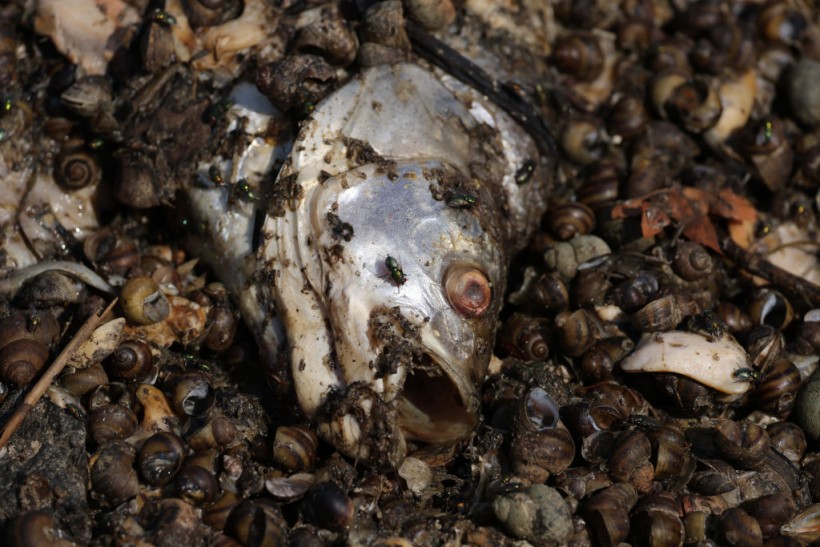San Francisco Bay is experiencing a red tide event that has raised concerns among environmentalists and residents.
Red tide is a phenomenon that occurs when certain types of algae grow rapidly and produce toxins or pigments that can harm marine life and humans.
Red tide can cause water to turn red, brown, or green, depending on the species of algae involved. Red tide can also cause fish kills, shellfish poisoning, respiratory irritation, and unpleasant odors.
Red tide returns to San Francisco Bay after a year
 (Photo : Sean Gallup/Getty Images)
(Photo : Sean Gallup/Getty Images)

The red tide was detected last weekend in water samples from Emeryville, the Berkeley Marina, Albany, and Marin County's Richardson Bay and Muir Beach, as per Phys.org.
The algae species associated with this bloom is Heterosigma akashiwo, which can cause oxidative stress and membrane damage to fish and other aquatic organisms.
The red tide is not yet killing fish, but experts said that people and pets should stay away from discolored water.
This is not the first time that San Francisco Bay has been affected by red tide. Last summer, a massive red tide event caused by the same algae species killed thousands of fish and other marine creatures, from tiny yellowfin goby to sharks and bat rays.
The fish die-off was unprecedented in the bay's history and alarmed scientists and conservationists.
The corpses of the dead animals littered the bay's beaches and shores for weeks.
Also Read: "Dead Fishes Everywhere": Red Tide Turned Florida Coast Toxic, Threatening Marine Ecosystem
The causes and consequences of red tide in San Francisco Bay
The causes of red tide in San Francisco Bay are complex and not fully understood. However, some factors that may contribute to the occurrence and severity of red tide include:
Nitrogen runoff
Nitrogen is a nutrient that can stimulate the growth of algae. Nitrogen can come from various sources, such as agricultural fertilizers, wastewater treatment plants, stormwater runoff, and atmospheric deposition.
San Francisco Bay receives a large amount of nitrogen from these sources, especially during wet seasons.
Warm water
Warm water can favor the growth of certain algae species, such as Heterosigma akashiwo. Warm water can also reduce the mixing and circulation of water layers, creating stratification that can trap algae near the surface.
Warm water can also lower the dissolved oxygen levels in the water, which can stress or suffocate fish and other animals.
Climate change
Climate change can exacerbate the conditions that lead to red tide. Climate change can increase the frequency and intensity of storms, droughts, heat waves, and wildfires, which can affect the water quality and quantity in the bay.
Climate change can also alter the timing and patterns of precipitation, runoff, wind, tides, and currents, which can affect the distribution and dynamics of algae in the bay.
The consequences of red tide in San Francisco Bay are serious and far-reaching. Red tide can have negative impacts on:
Marine life
Red tide can kill or harm fish and other aquatic organisms by producing toxins or depleting oxygen.
Red tide can also affect the food web and biodiversity of the bay by reducing the availability or quality of food sources for predators or consumers.
Red tide can also disrupt the habitats and migration patterns of some species by altering the water chemistry or clarity.
Human health
Red tide can pose health risks to humans who come into contact with contaminated water or air.
Red tide can cause skin irritation, eye irritation, respiratory irritation, or allergic reactions in some people who swim boat, or surf in affected areas.
Red tide can also cause shellfish poisoning in people who eat contaminated shellfish. Shellfish poisoning can cause nausea, vomiting, diarrhea, abdominal pain, tingling, numbness, dizziness, or paralysis.
Economy
Red tide can have economic costs for various sectors that depend on the bay's resources or services. Red tide can affect the fishing industry by reducing the catch or market value of fish and shellfish.
Red tide can affect the tourism industry by reducing the attractiveness or accessibility of recreational areas or activities.
Red tide can affect the transportation industry by causing delays or disruptions in shipping or ferry operations. Red tide can also affect the public infrastructure by damaging water pipes or dams.
Related article: Red Tide on Sarasota County Scatters Dead Fish on Beach, Shark Teeth Hunters Clean Up Instead - Florida
© 2024 NatureWorldNews.com All rights reserved. Do not reproduce without permission.

![Tsunami Hazard Zones: New US Map Shows Places at Risk of Flooding and Tsunamis Amid Rising Sea Levels [NOAA]](https://1471793142.rsc.cdn77.org/data/thumbs/full/70325/280/157/50/40/tsunami-hazard-zones-new-us-map-shows-places-at-risk-of-flooding-and-tsunamis-amid-rising-sea-levels-noaa.jpg)



